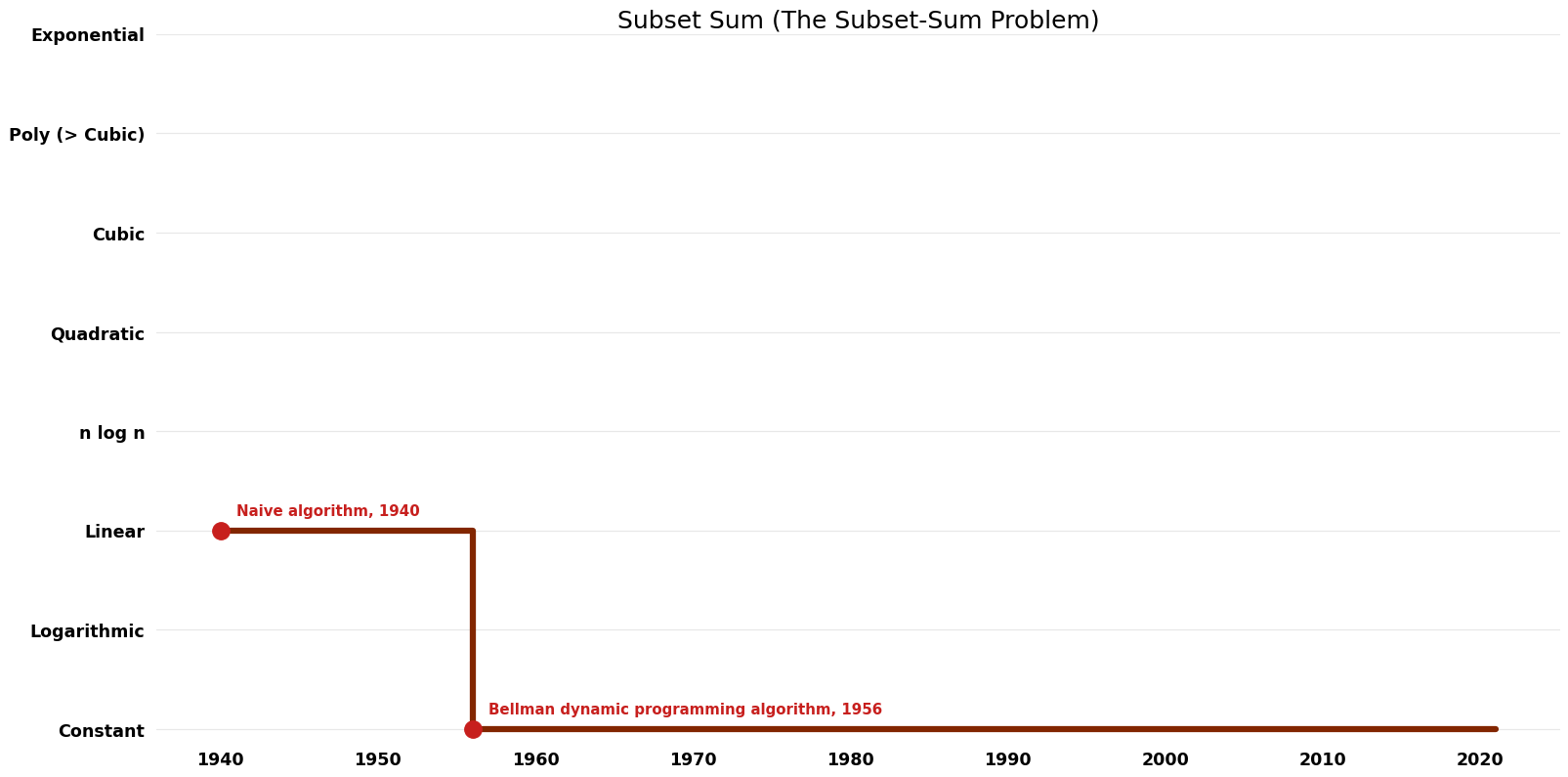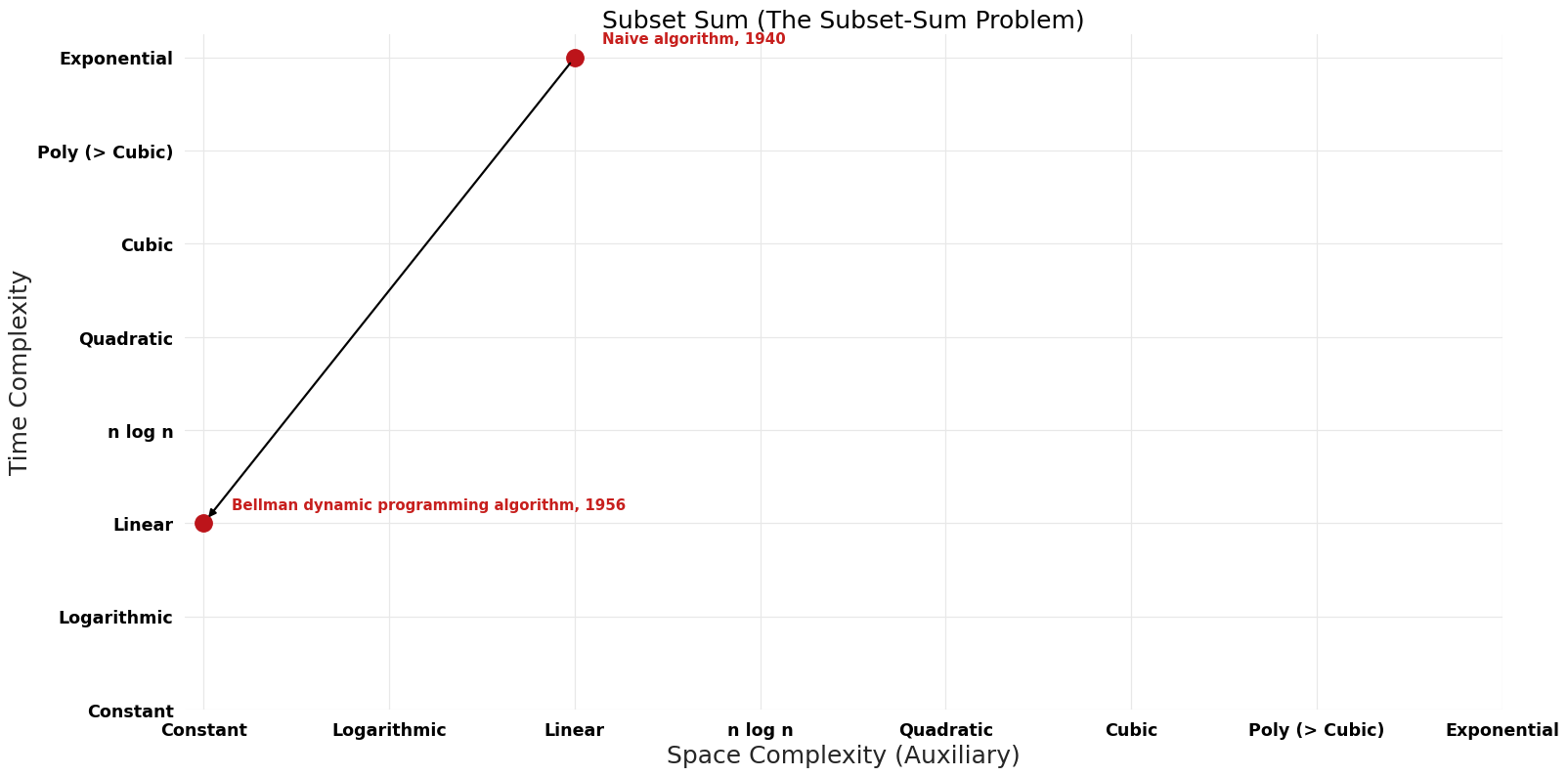Subset Sum: Difference between revisions
Jump to navigation
Jump to search
No edit summary |
No edit summary |
||
| Line 56: | Line 56: | ||
|} | |} | ||
== Time Complexity | == Time Complexity Graph == | ||
[[File:The Subset-Sum Problem - Subset Sum - Time.png|1000px]] | [[File:The Subset-Sum Problem - Subset Sum - Time.png|1000px]] | ||
== Space Complexity | == Space Complexity Graph == | ||
[[File:The Subset-Sum Problem - Subset Sum - Space.png|1000px]] | [[File:The Subset-Sum Problem - Subset Sum - Space.png|1000px]] | ||
== Pareto | == Pareto Frontier Improvements Graph == | ||
[[File:The Subset-Sum Problem - Subset Sum - Pareto Frontier.png|1000px]] | [[File:The Subset-Sum Problem - Subset Sum - Pareto Frontier.png|1000px]] | ||
Revision as of 14:04, 15 February 2023
Description
Given a set $S$ of integers and a target sum $t$, determine whether there is a subset of $S$ that sum to $t$.
Parameters
S: the set of integers
n: the number of integers in the set
n': the number of distinct elements in the set
t: the target sum
σ: sum of elements in the set
Table of Algorithms
| Name | Year | Time | Space | Approximation Factor | Model | Reference |
|---|---|---|---|---|---|---|
| Pisinger | 2003 | $O(nt/logt)$ | $O(t/logt)$ | Exact | Deterministic | Time & Space |
| Faaland | 1973 | $O(n' t)$ | $O(t)$ | Exact | Deterministic | Time & Space |
| Pferschy | 1999 | $O(n' t)$ | $O(t)$ | Exact | Deterministic | Time & Space |
| Klinz | 1999 | $O(σ^{({3}/{2})})$ | $O(t)$ | Exact | Deterministic | Time & Space |
| Epstein | 1997 | $\tilde{O}(n max(S))$ | $O(t logt)$ | Exact | Deterministic | Time & Space |
| Serang | 2014 | $\tilde{O}(n max(S))$ | $O(t logt)$ | Exact | Deterministic | Time & Space |
| Serang | 2015 | $\tilde{O}(n max(S))$ | $O(t logt)$ | Exact | Deterministic | Time & Space |
| Lokshtanov | 2010 | $\tilde{O}(n^{3} t)$ | $O(n^{2})$ | Exact | Deterministic | Time & Space |
| Horowitz and Sahni | 1974 | $O({2}^{(n/{2})})$ | $O({2}^{(n/{2})$}) | Exact | Deterministic | Time & Space |
| Bellman dynamic programming algorithm | 1956 | $O(n t)$ | $O(t)$ | Exact | Deterministic | Time & Space |
| Psinger | 1999 | $O(n max(S))$ | $O(t)$ | Exact | Deterministic | Time & Space |
| Koiliaris and Xu | 2019 | $\tilde{O}(min{\sqrt{n'}t, t^{5/4}, σ})$ | $O(t)$ | Exact | Deterministic | Time & Space |
| Bringman | 2017 | $\tilde{O}(nt^{1+\epsilon})$ | \tilde{O}(nt^\epsilon) | (n+t)^{-\Omega(1)} error | Randomized | Time & Space |
| Naive algorithm | 1940 | $O({2}^n * n)$ | $O(n)$ auxiliary | Exact | Deterministic | Space |
| Random Split Exponential algorithm | 1940 | $O({2}^{(n/{2})} * n)$ | $O({2}^{(n/{2})})$ | Exact | Deterministic | Space |
Time Complexity Graph
Space Complexity Graph
Pareto Frontier Improvements Graph
Reductions FROM Problem
| Problem | Implication | Year | Citation | Reduction |
|---|---|---|---|---|
| k-SAT | assume: SETH then: for any $\epsilon > {0}$ there exists a $\delta > {0}$ such that Subset Sum is not in time $O(T^{1-\epsilon}{2}^{\delta n})$, and $k$-Sum is not in time $O(T^{1-\epsilon}n^{\delta k})$ |
2022 | https://dl.acm.org/doi/full/10.1145/3450524 | link |


